This site is supported by our readers. We may earn a commission, at no cost to you, if you purchase through links.
We know how difficult it can be to keep your pleated skirt looking perfect. Ironing them is not always easy and, if you do not use the proper techniques, you can end up ruining your favorite piece of clothing.
But don’t worry – with our guide on how to iron a pleated skirt correctly, we’ll help make sure that doesn’t happen!
We’ll go over everything from choosing the right fabric type for your skirts and properly ironing them so they look neat all day long; discuss starch usage (or lack thereof) when it comes to keeping those pesky creases at bay; provide some handy tips for maintaining a freshly pressed look while wearing or storing away your skirts; as well as introduce Butler Luxury Hangers – specifically designed for hanging pleats without causing any damage.
So let’s get started: follow our simple instructions and soon enough you will have mastered the art of perfectly-pressed pleats!
Table Of Contents
Ironing Pleats
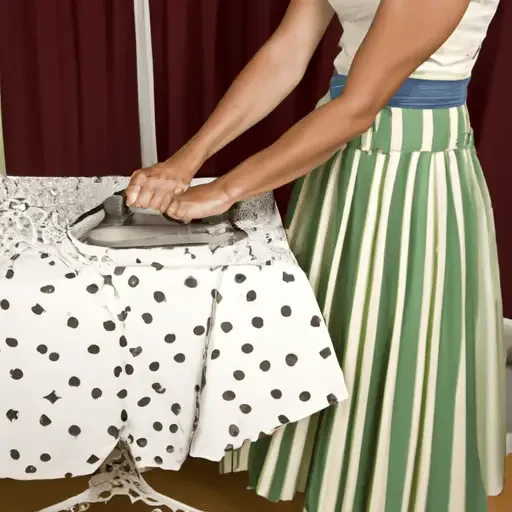 We give pleats a strong hold and smooth finish by pressing from top to bottom with attention to detail. Adding starch helps keep the pleat in place, but it’s important not to overdo it or use too much heat.
We give pleats a strong hold and smooth finish by pressing from top to bottom with attention to detail. Adding starch helps keep the pleat in place, but it’s important not to overdo it or use too much heat.
The right iron temperature will vary depending on the fabric of your skirt, so make sure you check care labels before getting started. For best results, hang dry skirts rather than putting them through a tumble cycle.
When hand washing skirts at home, take special care not to ruin any delicate details like lace trimming around the hemline.
With these tips in mind, we’re ready for skirt ironing and creating beautiful pleats that last all day long!
Skirt Ironing
Let’s keep our pleats pristine by giving them a few spritzes of starch and pressing them from top to bottom.
To begin, drape the skirt over an ironing board with the waistband at the narrow end. Prep by pressing all around this area. Then, find each pleat using your fingers to pinch its top and pulling down on its bottom if necessary.
Spritz it with some starch before you press from top to bottom. Be sure not to use too much that would make it stiff or create clumps!
If needed, pin in place for extra hold against heat settings when working in layers; otherwise, use caution when positioning your iron so as not to pass directly onto pins underneath fabrics.
For trousers instead of skirts, try out a trouser press for easier results!
Pants Ironing
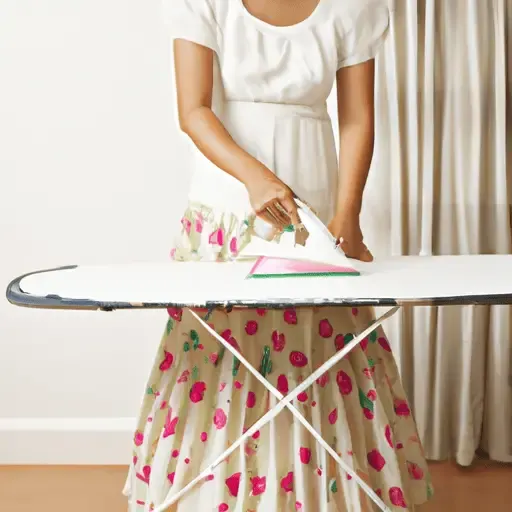
Ironing pleats in pants requires some special techniques. To start off on the right foot, we suggest turning your trousers inside out and laying them flat on an ironing board with back pockets facing up.
Prep by pressing all around the waistband before you find and pinch each pleat’s top end while gently tugging down at its bottom end. If necessary, use sewing pins or paper clips to keep it in place and then spray with starch for extra hold before pressing from top to bottom taking care not to force it too long or straighten any curves along its length.
When working through these ironing techniques, be sure that you’re using an appropriate type of iron set at the correct temperature for your fabric setting as well as keeping safety guidelines such as unplugging when finished in mind.
After following these steps carefully, you should have perfect pleated trousers ready for wear – no one will ever know their previous state were anything less than pristinely pressed perfection!
Starch
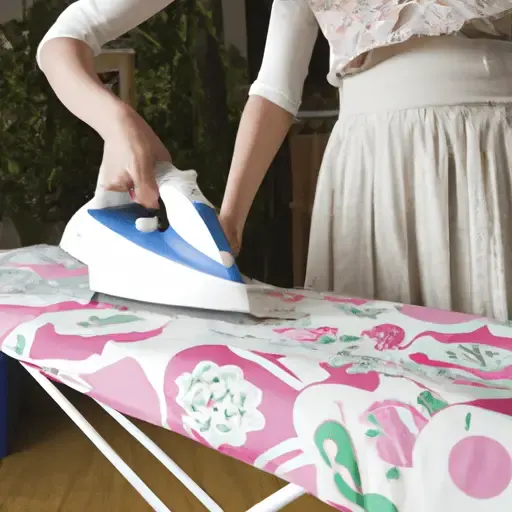
It also provides an extra layer of protection from cleaning stains, steaming tips, seam stabilization, and other seam finishes such as fraying or stretching out of shape.
If you’re looking for alternatives to traditional spray starches, then there are many on the market now including natural plant-based versions made from tapioca or potato flour which can do just as good a job at keeping fabrics well-pressed without having harsh chemicals included in their ingredients list.
With these helpful tips, your pleated skirt will look crisp and fresh all day long!
Tips
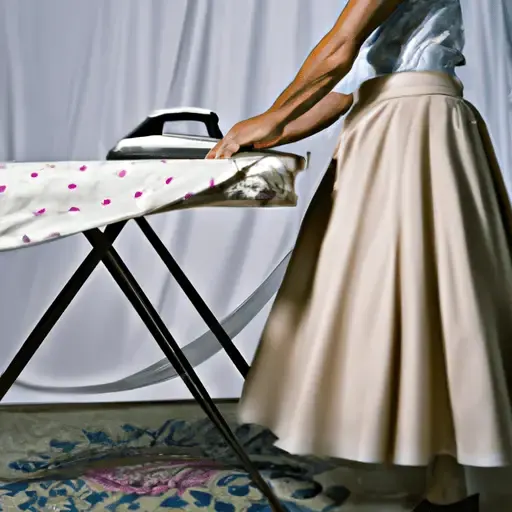
To achieve the best results, avoid dry cleaning solutions if possible as it may cause damage to delicate fabrics. Instead, opt for an appropriate spray starch alternative that will give your garment a lasting hold with minimal risk of fading or discoloration over time.
Finally, remember to hang your garments properly after ironing to maintain their shape and crispness until you’re ready to wear them again! This is especially important when dealing with pleats as gravity can quickly pull down any fabric that isn’t supported by strong hangers or other stabilization methods such as clips or pins placed inside pockets.
With careful attention paid during ironing sessions, proper maintenance afterwards should be relatively easy – leaving you looking freshly pressed every day!
5 Tips for Pleated Skirt Maintenance
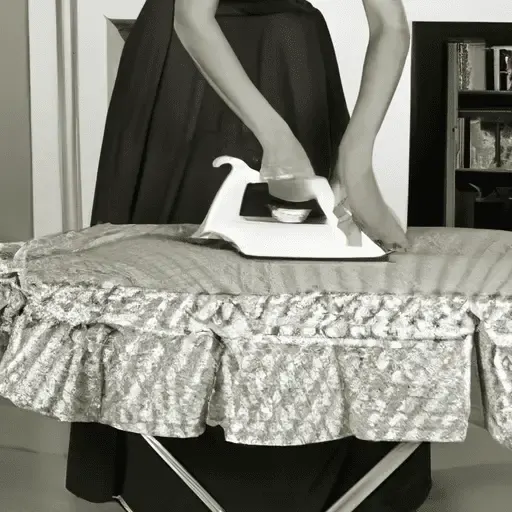
Hanging your skirt properly is also key; after you’re done ironing leave it out until fully cooled so that the pleats don’t lose their shape as they cool down. Consider dry cleaning if there are any mishaps – this will ensure that dirt and oil won’t set into fabrics like wool or silk over time.
Choose the Right Fabric
We must carefully consider the fabric of our pleated skirts when selecting them, as different fabrics require unique ironing techniques to achieve optimal results.
It’s important to read washing instructions for each garment and use only lukewarm temperatures when ironing. To make sure we’re taking good care of our pleats, it’s best to choose high-quality fabrics that possess natural wrinkle-resistant properties like linen or silk blends.
If using a synthetic material such as polyester or rayon, avoid excessive heat while pressing and be mindful of fabric shrinkage with prolonged exposure to steam irons.
With proper attention given during fabrication, along with mindful selection in terms of fabric type and subsequent maintenance procedures such as gentle laundering practices followed by appropriate temperature settings on an iron – we can ensure long-lasting beauty from every pleat in our skirt!
Ironing your pleats carefully will help keep these garments looking sharp no matter what occasion you may have planned next!
Iron Your Pleats Carefully
Let’s make sure our pleated garments remain sharp and beautiful by carefully pressing each fold with the correct temperature setting! Ironing pleats requires attention to detail, an iron, ironing board, sewing pins or paper clips, and spray starch.
The key is to press from top to bottom while finding and pinching the top of the pleat.
- Use a lower heat setting when pressing cloth as it’ll protect natural fibers from burning or melting.
- Consider different folding techniques such as gathering fabric at one end before beginning your work to ensure that all creases are pressed evenly across each section of fabric.
- Different types of irons require specific temperature settings, so use caution when adjusting them accordingly for better results.
- Wear a heat protection glove if necessary to keep hands safe during heated steam presses, which can sometimes cause burns on skin surfaces.
- Always check labels for special instructions regarding fabric composition and cleaning methods prior to using any hot tools near delicate materials.
By following these steps, we’ll be able to expertly care for our clothing items with perfect precision every time!
Hang Your Skirt Properly
We should properly hang our pleats to preserve their perfect perfection! To ensure your pleated skirt stays crisp and fresh, it’s important to take special care when hanging.
Make sure the hanger you use has a wide shoulder that won’t stretch or distort the shape of your garment. Avoid plastic hangers as they can cause creasing and permanent damage over time.
After taking off your skirt carefully from its hanger, store it flat in a dry place away from direct sunlight or other sources of heat. For extra protection against wrinkles while washing, try putting tissue paper between each layer of fabric before drying on low heat settings with steam setting if available for added softness.
Ironing tips vary according to different fabric types, so be sure to check out any instructions labels have included for further guidance on proper washing methods and recommended heat settings unique for each type!
Taking into consideration all these steps will help guarantee long-lasting results every time you wear them – ready for whatever life throws at you!
Leave Your Recently-ironed Skirt Out
Now that we’ve ironed our pleated skirt, let’s make sure it stays in perfect condition by leaving it out to air. Refreshing your pleats after ironing is an important part of maintaining a crisp and professional look for the lifespan of your clothing.
Leaving the skirt out allows any lingering steam from the heat settings to dissipate and prevents moisture build up which can lead to wrinkling or staining over time. Hang it on a sturdy hanger away from direct sunlight and avoid placing it near radiators or other sources of heat.
Allow natural airflow while airing indoors. With this simple step, you can ensure that all your hard work won’t be ruined! By following these laundry habits, incorporating seasonal care into our wardrobe maintenance routines, and using proper techniques when ironing garments with pleats, we’ll always have perfectly pressed items ready for every occasion.
Consider Dry Cleaning for Mishaps
When life hands us unexpected messes, dry cleaning can be the perfect solution. Whether your pleated skirt is stained or wrinkled beyond repair, it’s always a good idea to take extra caution when caring for this delicate piece of clothing.
Dry cleaning is an effective way to eliminate any stress caused by mishaps while keeping your pleats looking crisp and new. To ensure that our clothes last longer, we recommend safe storage away from heat and moisture, as well as using appropriate iron settings on different fabric types with proper ironing techniques that are tailored specifically for each type of garment.
With careful attention given to these details, you’ll be able to maintain the quality of your garments without having them damaged by regular wear-and-tear or incorrect handling methods over time. Dry cleaning will help keep all fabrics in their original condition while also protecting against shrinkage due to its ability not only to remove dirt but also to press out wrinkles.
Butler Luxury Hangers for Pleated Skirts
Let’s make sure our pleated skirts look their best with Butler Luxury Hangers! When it comes to keeping your pleats crisp and wrinkle-free, the type of hanger you use can play an important role.
The design of a Butler Luxury Hanger is specifically tailored for pleated skirts; its broad shoulder shape ensures that each pleat hangs properly so they don’t become creased or distorted over time. Additionally, these hangers are made from sturdy materials such as wood and metal which provide extra support while also avoiding any potential damage to delicate fabrics like silk or velvet.
With adjustable clamps at the top, you have complete control over what temperature setting your iron should be set at when pressing out wrinkles in between wears.
Lastly, if stain removal ever becomes necessary then simply mix warm water with mild detergent before gently blotting the affected area – no need to worry about ruining those perfectly pressed pleats either because this method won’t cause them any harm!
Frequently Asked Questions (FAQs)
What type of fabric should be used for pleated skirts?
When it comes to pleated skirts, seamless pleating is key. There are many different types of fabric that can be used for a perfect look and the best results when ironing your skirt.
Silk fabrics tend to work well as they allow for an even texture across all of the pleats, while other materials like cotton or rayon require extra attention in order to make sure each fold lays correctly.
Be sure you’re familiar with washing instructions before beginning any project and take care not to over-iron your garment – use low heat settings and be mindful of pressing techniques so you don’t ruin your hard work!
With these tips in mind, follow our ironing techniques outlined above for flawless results every time.
How often should pleated skirts be ironed?
We recommend ironing pleated skirts every one to two weeks, depending on the fabric and how often it’s worn.
When ironing a pleated skirt, use the right temperature for your fabric choice as steam cleaning can be too harsh. You should also pay attention to details such as adjusting the depth of each pleat and using appropriate stain removal techniques if needed.
To get a crisp look that lasts longer, finish with spray starch before pressing from top to bottom.
What is the best way to store pleated skirts when not in use?
We know how important it is to store pleated skirts correctly when they’re not in use. To keep them looking their best, you should steam press the fabric and cover with a cloth before storing away.
Fabric care also plays an important role; air drying is preferable over machine drying as this will help preserve the shape of your pleats, while folding techniques can be used to minimize creasing if needed.
By taking these extra steps, you’ll ensure that your pleated skirt looks just as good for years to come!
Can pleated skirts be machine-washed?
We’ve all experienced the frustration of trying to take care of delicate items like pleated skirts. Handwashing and dry cleaning are both viable options, but for those who prefer machine-washing, there’s a few important steps to keep in mind.
Iron types and settings can make or break crease removal with different fabric types, so it’s best to start off at the lowest heat setting available.
Steam ironing will help bring life back into old fabrics while helping remove stubborn creases from new ones. This process is akin to painting a masterpiece with your iron as you delicately glide over each pleat until they look brand new again.
How can I avoid wrinkles in pleated skirts?
We all know how frustrating wrinkles can be when it comes to pleated skirts. Whether you’re headed out for a special occasion or just want your skirt to stay wrinkle-free, there are some tips and tricks that can help avoid those pesky creases.
Steam ironing with the correct heat settings is key – too little heat won’t get the job done, but too much heat could cause damage! Applying even pressure along seams and using lint rollers for any excess fabric will also make sure your outfit looks perfect every time.
For tougher stains, try stain removers made specifically for fabrics before tackling them with an iron so you don’t end up making things worse instead of better!
Conclusion
We hope this article has given you the information you need to keep your pleated skirt looking fresh and new. With a few simple tips and the right tools, you’ll be able to maintain your pleated skirt with ease.
Be sure to choose a fabric that won’t wrinkle easily, avoid over-ironing, and hang your skirt properly. If you need to refresh your pleats, a quick spray of starch and careful ironing will do the trick.
With these tips, you’ll have your pleated skirt looking like a million bucks in no time.






